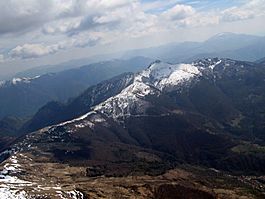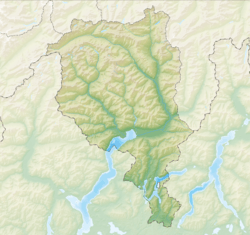Bogno facts for kids
Quick facts for kids
Bogno
|
||
|---|---|---|
 |
||
|
||
| Country | Switzerland | |
| Canton | Ticino | |
| District | Lugano | |
| Area | ||
| • Total | 4.2 km2 (1.6 sq mi) | |
| Elevation | 960 m (3,150 ft) | |
| Population
(Dec 2011)
|
||
| • Total | 144 | |
| • Density | 34.3/km2 (88.8/sq mi) | |
| Postal code |
6951
|
|
| Surrounded by | Cavargna (IT-CO), Certara, Valcolla, Val Rezzo (IT-CO) | |
Bogno was once a small town, called a municipality, in the Lugano area of Ticino in Switzerland. On April 14, 2013, Bogno and several other nearby towns like Cadro, Carona, Certara, Cimadera, Valcolla, and Sonvico all joined together to become part of the larger city of Lugano.
Contents
History of Bogno
Bogno was first mentioned way back in the 1200s. It started as a place where people would stay for a short time while moving their animals to different pastures. These were like temporary camps for herders. Over time, it grew into a permanent village. The pastures were originally used by people from other nearby villages.
The local church, called S. Rocco, was first mentioned in 1591. It was fixed up and made bigger in 1780. Later, in 1811, it was taken down by the local church community.
For a long time, Bogno was quite isolated. Its people had strong connections with Italian villages nearby, which they reached by crossing the S. Lucio pass, a mountain path about 1,541 meters (5,056 feet) high. This changed in 1854 when the first road was built into the valley. Another road was finished in 1886. These new roads connected Bogno more closely to the city of Lugano.
In the 1900s, fewer people worked in farming. This caused many residents to move to Lugano for jobs. Because of this, the number of people living in Bogno dropped a lot. Today, many houses in Bogno are used as vacation homes. The main businesses in the town are a carpenter's shop and an inn.
Geography of Bogno
Bogno is located in a valley called Val Colla. It sits where several small streams meet to form the Cassarate River. It is also located below the San Lucio Pass.
Before it merged with Lugano, Bogno covered an area of about 4.2 square kilometers (1.6 square miles). A small part of this land, about 6.4%, was used for farming. More than half of the land, about 53.7%, was covered by forests. About 3.1% of the land had buildings or roads on it. The rest, about 6.7%, was unproductive land like rocky areas.
Most of the forested land was dense forest. A small part had orchards or groups of trees. For farming, most of the land was used for growing crops or for mountain pastures where animals could graze.
Coat of Arms
A coat of arms is like a special symbol or logo for a town or family. Bogno's coat of arms shows a green oak tree with a black trunk. It stands on a green hill, and there's a wavy silver bar below it. The background color is gold.
People of Bogno (Demographics)
In 2011, Bogno had a population of 144 people. In 2008, about 12.9% of the people living there were foreign nationals, meaning they were not Swiss citizens.
Most people in Bogno speak Italian, which is about 84.9% of the population. German is the second most common language, spoken by 11.8% of the people. A small number, 1.1%, speak French.
In 2009, the population of Bogno included:
- 10 children (7.6%) aged 0 to 9 years old.
- 15 teenagers (11.5%) aged 10 to 19.
- Adults aged 20 to 59 made up about 52% of the population.
- Older adults aged 60 and above made up about 29% of the population.
In 2000, there were 41 homes in Bogno, with about 2.2 people living in each home on average. Most of the buildings were single-family homes. Many apartments in Bogno were used only during certain seasons, like for vacations.
Here's how the population of Bogno has changed over time:
| year | population |
|---|---|
| 1591 | 20 Hearths |
| 1786 | 254 |
| 1828 | 250 |
| 1850 | 261 |
| 1871 | 412 |
| 1900 | 225 |
Economy
In 2007, the unemployment rate in Bogno was 4.82%. This means that about 4.82% of the people who wanted to work could not find a job.
In 2005, a few people worked in the primary economic sector (like farming). Two people worked in the secondary sector (like manufacturing). Eleven people worked in the tertiary sector (like services). Overall, 37 residents of Bogno had jobs, and about 40.5% of them were women.
Most people who lived in Bogno in 2000 traveled outside the town for work. About 78.4% of working people used a private car to get to their jobs. In 2009, there were no hotels in Bogno.
Religion
According to a survey in 2000, most people in Bogno were Roman Catholic, about 83.9%. A smaller group, about 3.2%, belonged to the Swiss Reformed Church. Some people belonged to other churches, and a few did not answer the question about their religion.
Education
In Switzerland, people are generally well educated. In Bogno, about 58.3% of adults aged 25 to 64 had finished either high school or gone on to higher education, like a university or a special college called a Fachhochschule.
In 2009, there were 15 students in Bogno. The education system in Ticino, the canton where Bogno is located, offers up to three years of optional kindergarten. Two students in Bogno attended primary school, which lasts for five years. For middle school, eight students were in a two-year program.
After middle school, students can choose different paths. Some go to vocational schools to learn a trade, while others prepare for university. In Bogno, one student was attending vocational school full-time, and four were attending part-time. In 2000, four students from Bogno went to schools outside the town.
Images for kids
See also
 In Spanish: Bogno para niños
In Spanish: Bogno para niños






